Australian Immigration: Historical Development and Current Issues
VerifiedAdded on 2021/04/20
|5
|892
|48
Essay
AI Summary
This essay provides a comprehensive overview of the history of immigration in Australia, beginning with European settlements and the evolution of the migration system. It details the shift from the White Australia Policy to multiculturalism, highlighting key reforms and agreements that shaped the country's demographic landscape. The essay discusses the introduction of structured selection based on skills and attributes, replacing the quota system, and the establishment of Australia as a multicultural society. It also addresses the criticisms faced by Australia regarding immigration detention practices, particularly the indefinite detention of asylum seekers, and the concerns raised by international organizations like the United Nations and Amnesty International. The essay concludes by suggesting potential solutions to address the issue of immigration detention, such as setting time limits for assessment and improving detention facilities, to ensure a fair and just immigration system.
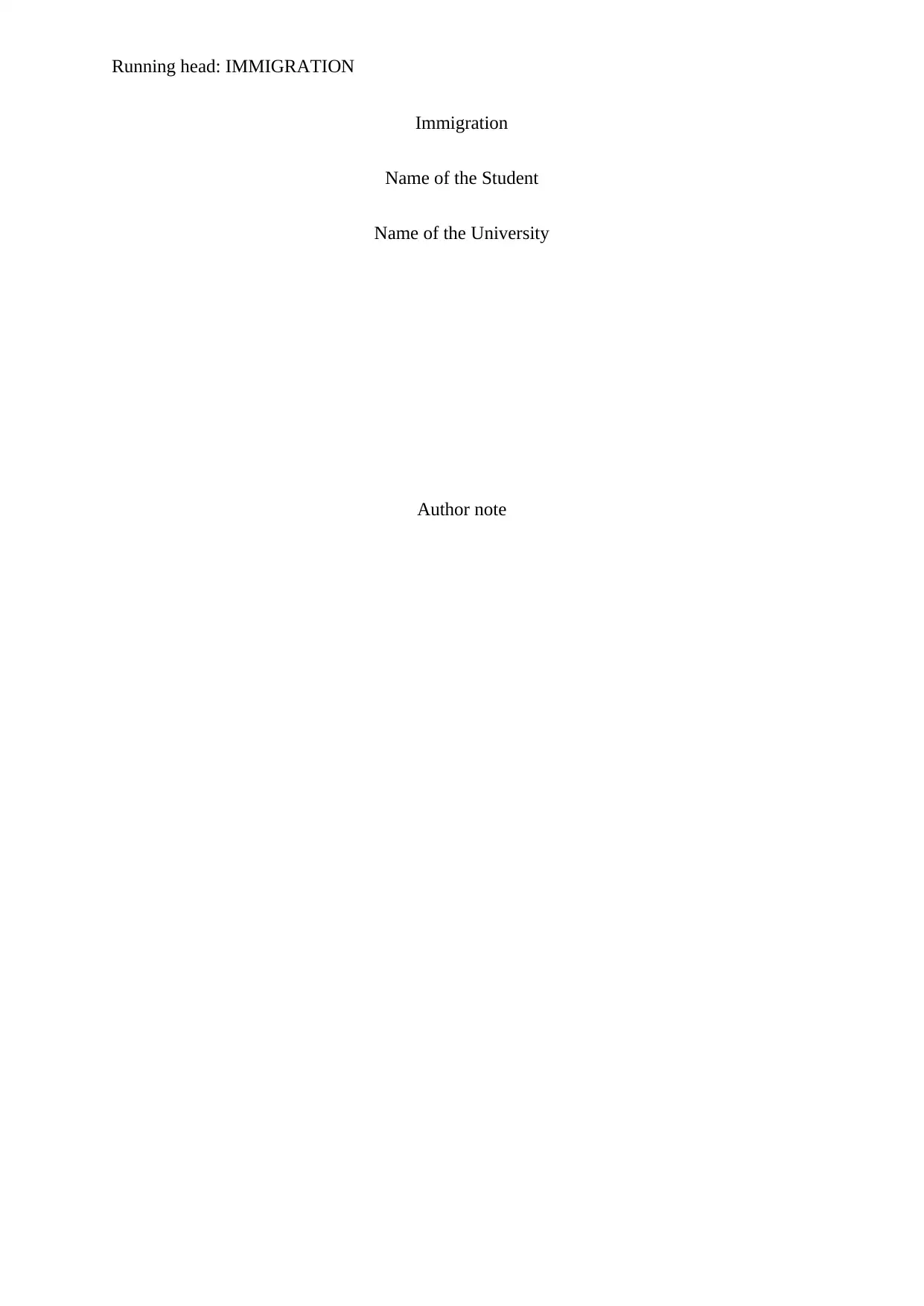
Running head: IMMIGRATION
Immigration
Name of the Student
Name of the University
Author note
Immigration
Name of the Student
Name of the University
Author note
Paraphrase This Document
Need a fresh take? Get an instant paraphrase of this document with our AI Paraphraser
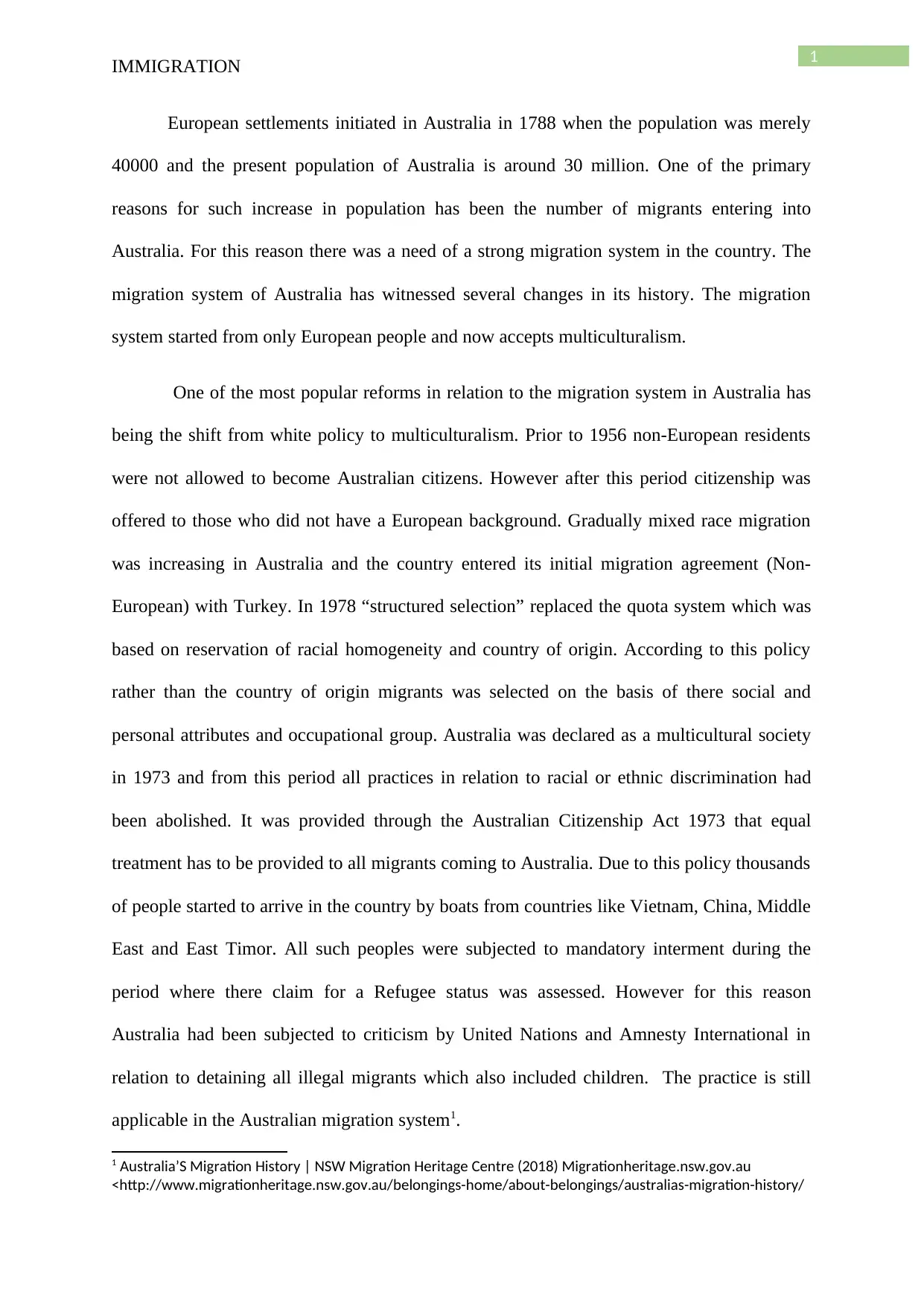
1
IMMIGRATION
European settlements initiated in Australia in 1788 when the population was merely
40000 and the present population of Australia is around 30 million. One of the primary
reasons for such increase in population has been the number of migrants entering into
Australia. For this reason there was a need of a strong migration system in the country. The
migration system of Australia has witnessed several changes in its history. The migration
system started from only European people and now accepts multiculturalism.
One of the most popular reforms in relation to the migration system in Australia has
being the shift from white policy to multiculturalism. Prior to 1956 non-European residents
were not allowed to become Australian citizens. However after this period citizenship was
offered to those who did not have a European background. Gradually mixed race migration
was increasing in Australia and the country entered its initial migration agreement (Non-
European) with Turkey. In 1978 “structured selection” replaced the quota system which was
based on reservation of racial homogeneity and country of origin. According to this policy
rather than the country of origin migrants was selected on the basis of there social and
personal attributes and occupational group. Australia was declared as a multicultural society
in 1973 and from this period all practices in relation to racial or ethnic discrimination had
been abolished. It was provided through the Australian Citizenship Act 1973 that equal
treatment has to be provided to all migrants coming to Australia. Due to this policy thousands
of people started to arrive in the country by boats from countries like Vietnam, China, Middle
East and East Timor. All such peoples were subjected to mandatory interment during the
period where there claim for a Refugee status was assessed. However for this reason
Australia had been subjected to criticism by United Nations and Amnesty International in
relation to detaining all illegal migrants which also included children. The practice is still
applicable in the Australian migration system1.
1 Australia’S Migration History | NSW Migration Heritage Centre (2018) Migrationheritage.nsw.gov.au
<http://www.migrationheritage.nsw.gov.au/belongings-home/about-belongings/australias-migration-history/
IMMIGRATION
European settlements initiated in Australia in 1788 when the population was merely
40000 and the present population of Australia is around 30 million. One of the primary
reasons for such increase in population has been the number of migrants entering into
Australia. For this reason there was a need of a strong migration system in the country. The
migration system of Australia has witnessed several changes in its history. The migration
system started from only European people and now accepts multiculturalism.
One of the most popular reforms in relation to the migration system in Australia has
being the shift from white policy to multiculturalism. Prior to 1956 non-European residents
were not allowed to become Australian citizens. However after this period citizenship was
offered to those who did not have a European background. Gradually mixed race migration
was increasing in Australia and the country entered its initial migration agreement (Non-
European) with Turkey. In 1978 “structured selection” replaced the quota system which was
based on reservation of racial homogeneity and country of origin. According to this policy
rather than the country of origin migrants was selected on the basis of there social and
personal attributes and occupational group. Australia was declared as a multicultural society
in 1973 and from this period all practices in relation to racial or ethnic discrimination had
been abolished. It was provided through the Australian Citizenship Act 1973 that equal
treatment has to be provided to all migrants coming to Australia. Due to this policy thousands
of people started to arrive in the country by boats from countries like Vietnam, China, Middle
East and East Timor. All such peoples were subjected to mandatory interment during the
period where there claim for a Refugee status was assessed. However for this reason
Australia had been subjected to criticism by United Nations and Amnesty International in
relation to detaining all illegal migrants which also included children. The practice is still
applicable in the Australian migration system1.
1 Australia’S Migration History | NSW Migration Heritage Centre (2018) Migrationheritage.nsw.gov.au
<http://www.migrationheritage.nsw.gov.au/belongings-home/about-belongings/australias-migration-history/
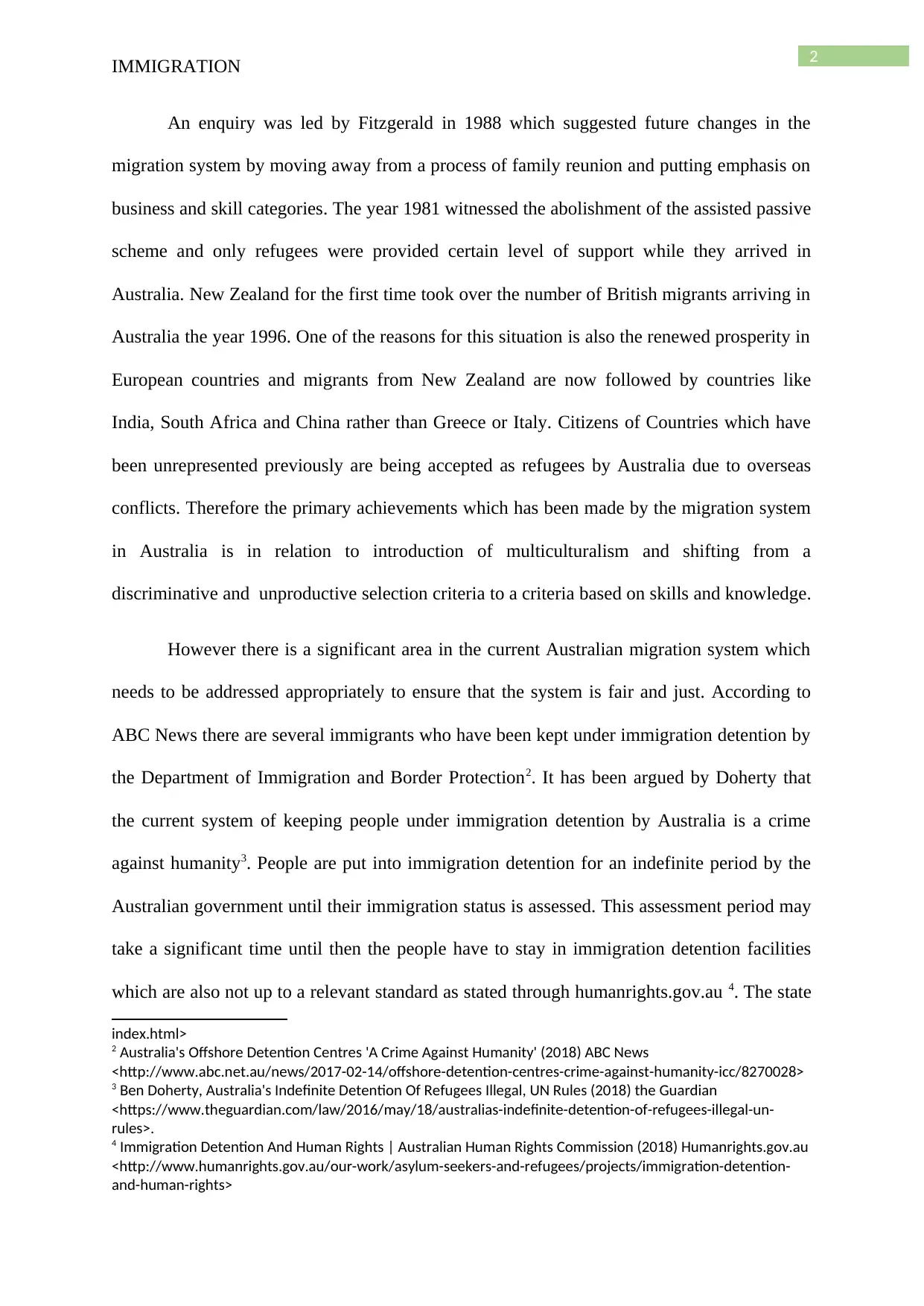
2
IMMIGRATION
An enquiry was led by Fitzgerald in 1988 which suggested future changes in the
migration system by moving away from a process of family reunion and putting emphasis on
business and skill categories. The year 1981 witnessed the abolishment of the assisted passive
scheme and only refugees were provided certain level of support while they arrived in
Australia. New Zealand for the first time took over the number of British migrants arriving in
Australia the year 1996. One of the reasons for this situation is also the renewed prosperity in
European countries and migrants from New Zealand are now followed by countries like
India, South Africa and China rather than Greece or Italy. Citizens of Countries which have
been unrepresented previously are being accepted as refugees by Australia due to overseas
conflicts. Therefore the primary achievements which has been made by the migration system
in Australia is in relation to introduction of multiculturalism and shifting from a
discriminative and unproductive selection criteria to a criteria based on skills and knowledge.
However there is a significant area in the current Australian migration system which
needs to be addressed appropriately to ensure that the system is fair and just. According to
ABC News there are several immigrants who have been kept under immigration detention by
the Department of Immigration and Border Protection2. It has been argued by Doherty that
the current system of keeping people under immigration detention by Australia is a crime
against humanity3. People are put into immigration detention for an indefinite period by the
Australian government until their immigration status is assessed. This assessment period may
take a significant time until then the people have to stay in immigration detention facilities
which are also not up to a relevant standard as stated through humanrights.gov.au 4. The state
index.html>
2 Australia's Offshore Detention Centres 'A Crime Against Humanity' (2018) ABC News
<http://www.abc.net.au/news/2017-02-14/offshore-detention-centres-crime-against-humanity-icc/8270028>
3 Ben Doherty, Australia's Indefinite Detention Of Refugees Illegal, UN Rules (2018) the Guardian
<https://www.theguardian.com/law/2016/may/18/australias-indefinite-detention-of-refugees-illegal-un-
rules>.
4 Immigration Detention And Human Rights | Australian Human Rights Commission (2018) Humanrights.gov.au
<http://www.humanrights.gov.au/our-work/asylum-seekers-and-refugees/projects/immigration-detention-
and-human-rights>
IMMIGRATION
An enquiry was led by Fitzgerald in 1988 which suggested future changes in the
migration system by moving away from a process of family reunion and putting emphasis on
business and skill categories. The year 1981 witnessed the abolishment of the assisted passive
scheme and only refugees were provided certain level of support while they arrived in
Australia. New Zealand for the first time took over the number of British migrants arriving in
Australia the year 1996. One of the reasons for this situation is also the renewed prosperity in
European countries and migrants from New Zealand are now followed by countries like
India, South Africa and China rather than Greece or Italy. Citizens of Countries which have
been unrepresented previously are being accepted as refugees by Australia due to overseas
conflicts. Therefore the primary achievements which has been made by the migration system
in Australia is in relation to introduction of multiculturalism and shifting from a
discriminative and unproductive selection criteria to a criteria based on skills and knowledge.
However there is a significant area in the current Australian migration system which
needs to be addressed appropriately to ensure that the system is fair and just. According to
ABC News there are several immigrants who have been kept under immigration detention by
the Department of Immigration and Border Protection2. It has been argued by Doherty that
the current system of keeping people under immigration detention by Australia is a crime
against humanity3. People are put into immigration detention for an indefinite period by the
Australian government until their immigration status is assessed. This assessment period may
take a significant time until then the people have to stay in immigration detention facilities
which are also not up to a relevant standard as stated through humanrights.gov.au 4. The state
index.html>
2 Australia's Offshore Detention Centres 'A Crime Against Humanity' (2018) ABC News
<http://www.abc.net.au/news/2017-02-14/offshore-detention-centres-crime-against-humanity-icc/8270028>
3 Ben Doherty, Australia's Indefinite Detention Of Refugees Illegal, UN Rules (2018) the Guardian
<https://www.theguardian.com/law/2016/may/18/australias-indefinite-detention-of-refugees-illegal-un-
rules>.
4 Immigration Detention And Human Rights | Australian Human Rights Commission (2018) Humanrights.gov.au
<http://www.humanrights.gov.au/our-work/asylum-seekers-and-refugees/projects/immigration-detention-
and-human-rights>
⊘ This is a preview!⊘
Do you want full access?
Subscribe today to unlock all pages.

Trusted by 1+ million students worldwide
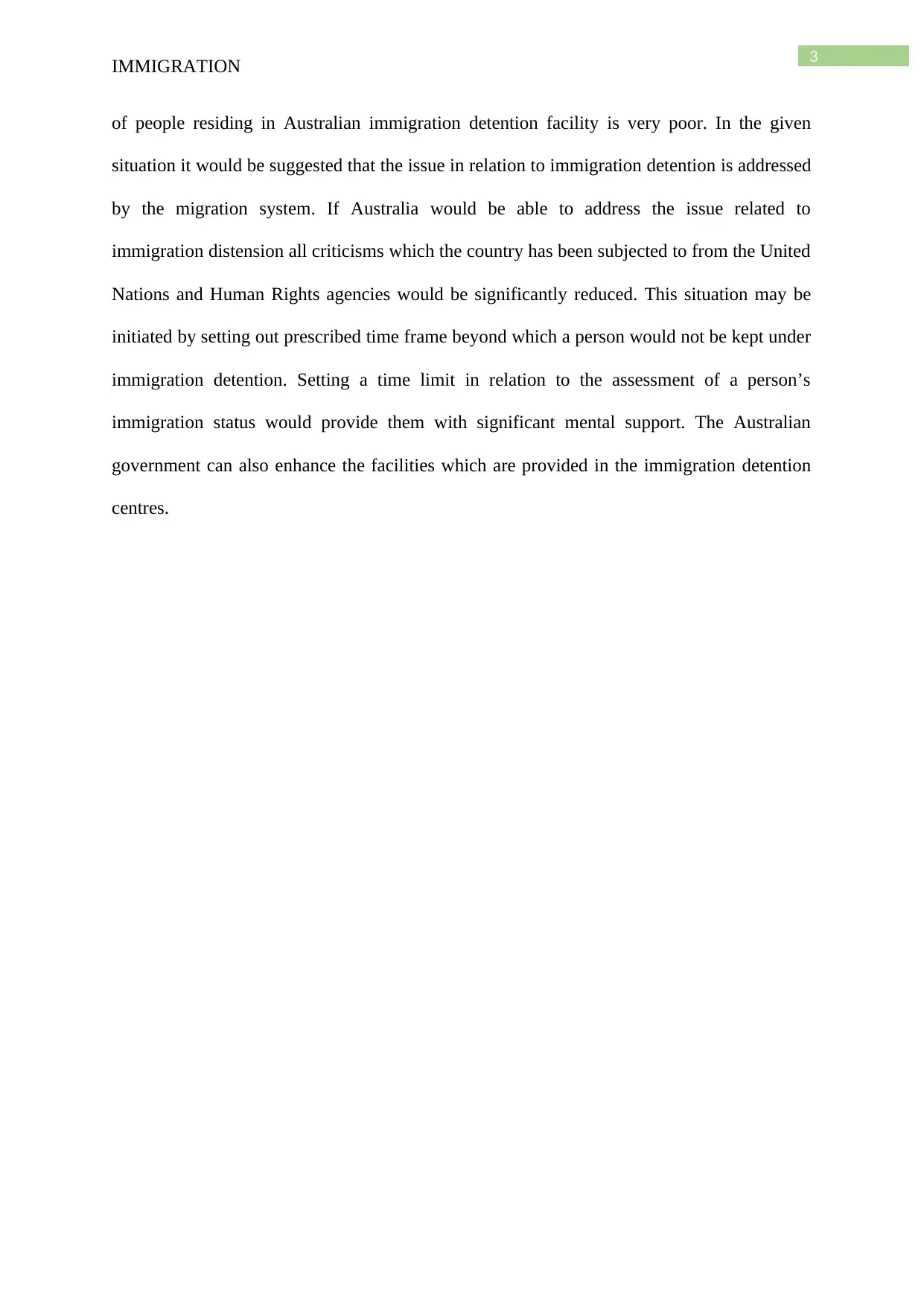
3
IMMIGRATION
of people residing in Australian immigration detention facility is very poor. In the given
situation it would be suggested that the issue in relation to immigration detention is addressed
by the migration system. If Australia would be able to address the issue related to
immigration distension all criticisms which the country has been subjected to from the United
Nations and Human Rights agencies would be significantly reduced. This situation may be
initiated by setting out prescribed time frame beyond which a person would not be kept under
immigration detention. Setting a time limit in relation to the assessment of a person’s
immigration status would provide them with significant mental support. The Australian
government can also enhance the facilities which are provided in the immigration detention
centres.
IMMIGRATION
of people residing in Australian immigration detention facility is very poor. In the given
situation it would be suggested that the issue in relation to immigration detention is addressed
by the migration system. If Australia would be able to address the issue related to
immigration distension all criticisms which the country has been subjected to from the United
Nations and Human Rights agencies would be significantly reduced. This situation may be
initiated by setting out prescribed time frame beyond which a person would not be kept under
immigration detention. Setting a time limit in relation to the assessment of a person’s
immigration status would provide them with significant mental support. The Australian
government can also enhance the facilities which are provided in the immigration detention
centres.
Paraphrase This Document
Need a fresh take? Get an instant paraphrase of this document with our AI Paraphraser
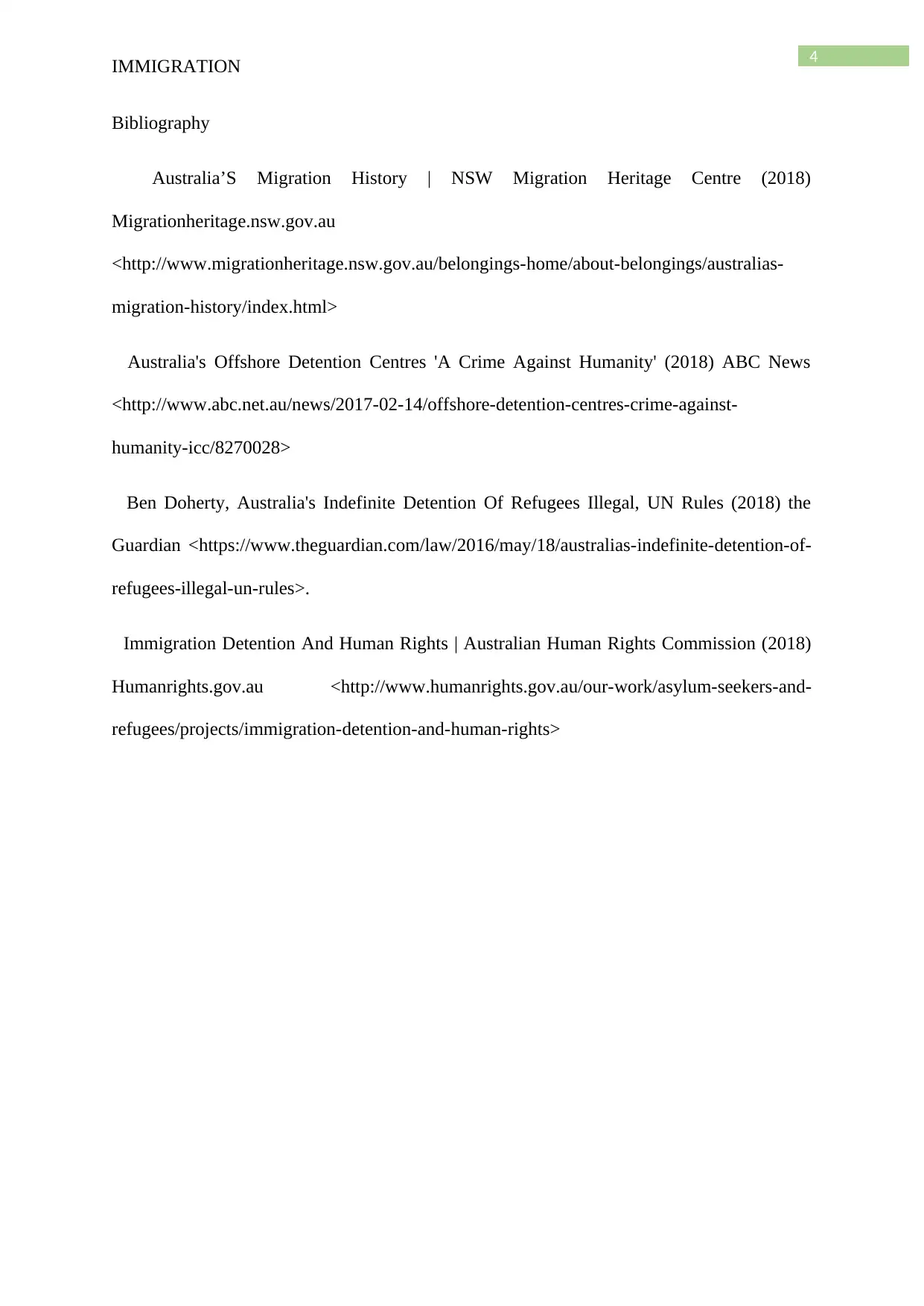
4
IMMIGRATION
Bibliography
Australia’S Migration History | NSW Migration Heritage Centre (2018)
Migrationheritage.nsw.gov.au
<http://www.migrationheritage.nsw.gov.au/belongings-home/about-belongings/australias-
migration-history/index.html>
Australia's Offshore Detention Centres 'A Crime Against Humanity' (2018) ABC News
<http://www.abc.net.au/news/2017-02-14/offshore-detention-centres-crime-against-
humanity-icc/8270028>
Ben Doherty, Australia's Indefinite Detention Of Refugees Illegal, UN Rules (2018) the
Guardian <https://www.theguardian.com/law/2016/may/18/australias-indefinite-detention-of-
refugees-illegal-un-rules>.
Immigration Detention And Human Rights | Australian Human Rights Commission (2018)
Humanrights.gov.au <http://www.humanrights.gov.au/our-work/asylum-seekers-and-
refugees/projects/immigration-detention-and-human-rights>
IMMIGRATION
Bibliography
Australia’S Migration History | NSW Migration Heritage Centre (2018)
Migrationheritage.nsw.gov.au
<http://www.migrationheritage.nsw.gov.au/belongings-home/about-belongings/australias-
migration-history/index.html>
Australia's Offshore Detention Centres 'A Crime Against Humanity' (2018) ABC News
<http://www.abc.net.au/news/2017-02-14/offshore-detention-centres-crime-against-
humanity-icc/8270028>
Ben Doherty, Australia's Indefinite Detention Of Refugees Illegal, UN Rules (2018) the
Guardian <https://www.theguardian.com/law/2016/may/18/australias-indefinite-detention-of-
refugees-illegal-un-rules>.
Immigration Detention And Human Rights | Australian Human Rights Commission (2018)
Humanrights.gov.au <http://www.humanrights.gov.au/our-work/asylum-seekers-and-
refugees/projects/immigration-detention-and-human-rights>
1 out of 5
Related Documents
Your All-in-One AI-Powered Toolkit for Academic Success.
+13062052269
info@desklib.com
Available 24*7 on WhatsApp / Email
![[object Object]](/_next/static/media/star-bottom.7253800d.svg)
Unlock your academic potential
Copyright © 2020–2025 A2Z Services. All Rights Reserved. Developed and managed by ZUCOL.





